Fly & drive in the north-east of South Africa
National parks Pilanesberg, Marakele and Kruger
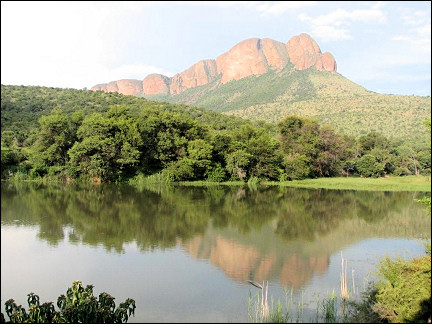
|
In Pilanesberg an elephant herd crosses the road and white rhinoes rummage about, but in Marakele the game hides behind thorny bushes. From Hannah Game Lodge the Mpumalanga Panorama Route passes highlights like God's Window, Pinnacle, Bourke's Luck Potholes and Three Rondavels. The Kruger Park has a lot of game, among which the Big Five: elephants, lions, rhinoes, buffaloes and leopard.
Travelogue & photos: Marianne van Rossum
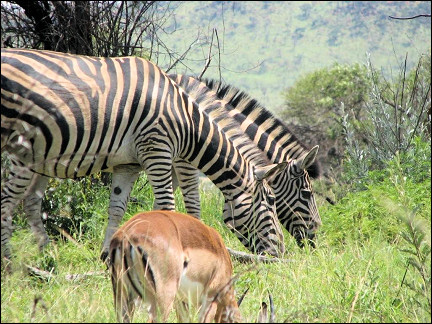
|
From Johannesburg Airport we drive our rental car to Pilanesberg National Park. That sounds easier than it is: after a couple of wrong turns, we decide to have lunch and ask for directions.
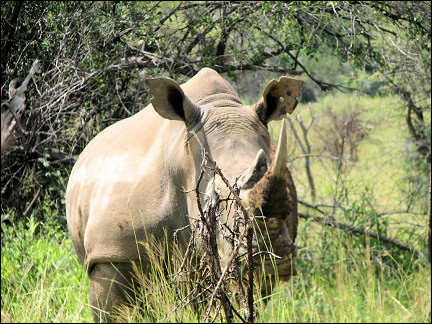
|
Kelvin and his wife get in their car and tell us to follow them. Because they're afraid we'll get lost again and won't reach our destination safely before dark, they take us all the way to the Manyane Gate of Pilanesberg. A two hours drive! They even give us their phone number, in case we need them again.
Pilanesberg National Park
An elephant herd crosses the road right in front of our car
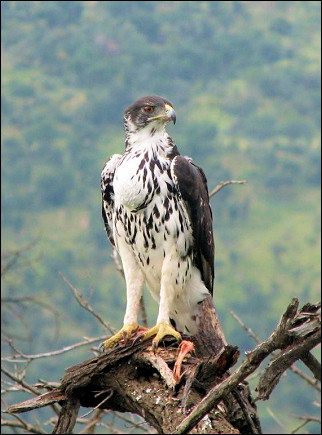
|
Pilanesberg National Park is a beautiful park with a 55,000 hectares surface in an extinct volcano crater, which explains its circular shape.
It has woods, valleys and rolling grassland. It houses around 10,000 animals. The Big Five (elephant, lion, rhino, buffalo and leopard), but also other kinds of game. And over 300 kinds of birds.
We stay in a gorgeous cottage with a large terrace. It stays hot all night.
We get up at 5:45 AM for a game drive. The roads in Pilanesberg are unpaved, but easy to drive on. Everywhere in the park are picnic sites and observation huts.
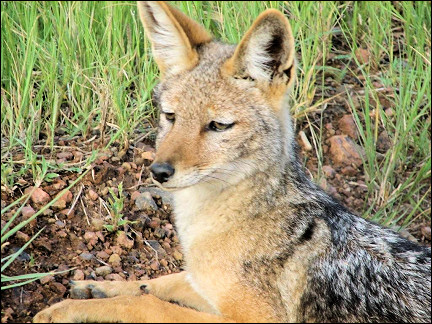
|
We see hippoes, a jackal lies on the side of the road and a lion quickly walks away from us. The birds wake up. A beautiful African hawk eagle poses for us. A wildebeest herd crosses the road. Africa at its best.
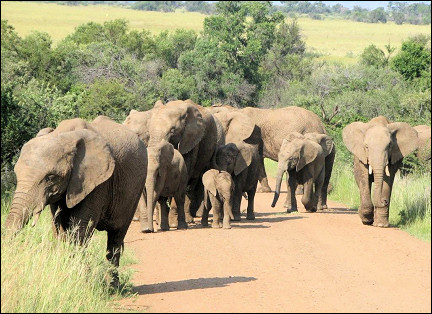
|
Back at our cottage, we see one of the most beautiful birds in the park, the black-headed gonolek; we also see a red-billed hornbill.
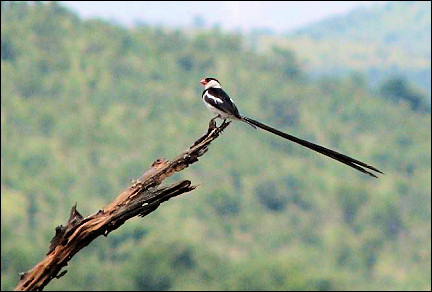
|
Around noon we go back into the wonderful park. An elephant herd crosses the road just aheas of us; we see zebras, giraffes, waterbucks and a white rhino with calf.
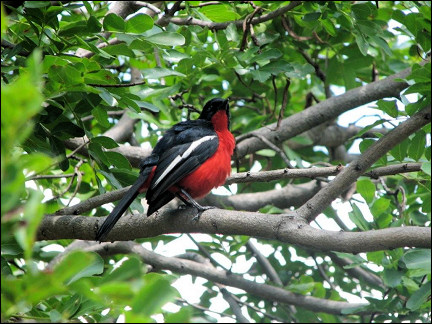
|
In one of the observation huts we spend a lot of time looking at the lake, with hippoes, wildebeests and birds, like the pin-tailed whydah. This is a small black-and-white bird with a very long tail.
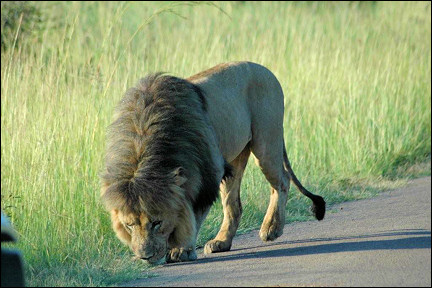
|
Next morning we visit the park with a guide at 6 AM. A lion appears from the bush and keeps walking ahead of our car for a while. He doesn't care whether we are here or not. Again we see white rhinoes, elephants and many other kinds of game. We're back at the cottage by 8:30 AM.
Marakele National Park
Lowlands, marshes, thorny fields and woods
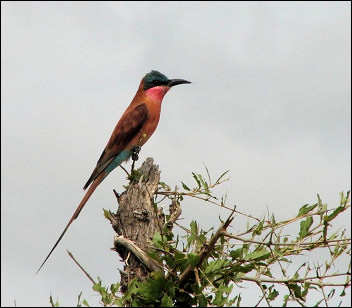
|
After a tasty breakfast (buffet) we leave Pilanesberg for Marakele National Park. This park, which is located west of the Waterberg, was neglected for a long time, but was reopened after a thorough face lift in 2003 by Nelson Mandela and the (now deceased) Prince Bernhard of the Netherlands.
On the way we get groceries in Thabazimbi, a village near Marakele. Over the next few days we'll be far from civilisation, so we have to bring everything with us.
At noon we arrive in Marakele National Park. It's still another 17 km to the Tlopi Tented Camp, where we will stay for two days. During our first game drive, we only see ostriches and some small game. The tents look great, each has its own shower and toilet.
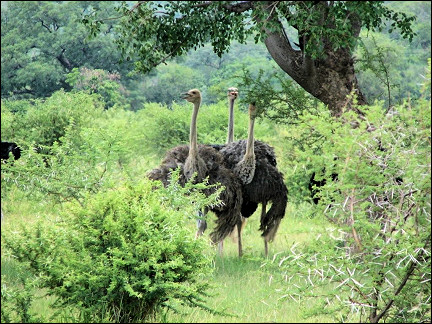
|
Marakele has lowlands, marshes, thorn fields and woods. There are many sago palms. It is in general densely overgrown. Even though all kinds of game are present, they are often hard to find, due to the dense overgrowth. There are also over 300 kinds of birds.
Marakele is considered the national park with the greatest natural beauty. In the Tswana language, "Marakele" means "haven" or "sanctuary" and that is exactly what it is for some endangered kinds of antelope, like the rare roan antelope. On the towering rocks in the south of Marakele hundreds of Cape vultures nest. But you need a good 4x4 to get there.
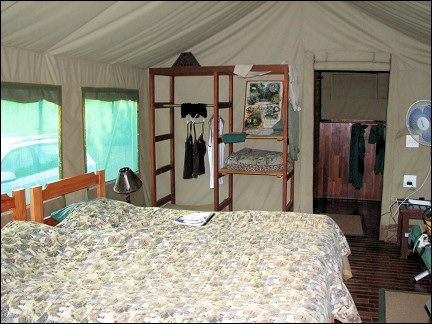
|
Towards the evening we drive around for a while, but because of the dense overgrowth, we only see some small game. Our tent has a great view of the Apiesrivierpoort Dam. On the other site we see impalas and an African osprey.
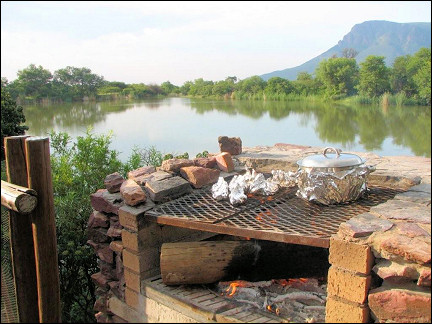
|
There is a power outage; fortunately we have candles and flashlights and there is a barbecue. It's not allowed to gahter wood, but we still do it, how else are we supposed to eat?
Because the refrigerator also doesn't work, we can't store anything, so we put both the fish and the chicken on the barbecue. Tomorrow we'll see what we do.
Welgevonden
On the way we see zebras, giraffes, jackals and lots of birds
We want to visit the adjacent park Welgevonden. The main entrance is farther away than we thought, around 80 km. Once there, a disappointment awaits us: we are not allowed to enter.
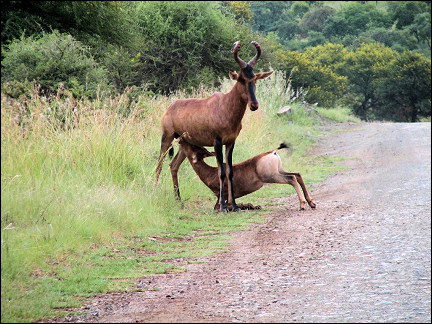
|
The only way to visit this private park is to stay there, which is very expensive. There is one other option: to book a safari in a lodge at the South Gate. But it's already too late to do this today.
We drive back, trying to spot game. It is a beautiful drive, but we have to hurry to be back at our tent before dark. On the way we see zebras, giraffes, tsessebes (which look a little like hartebeest) two jackals and many birds.
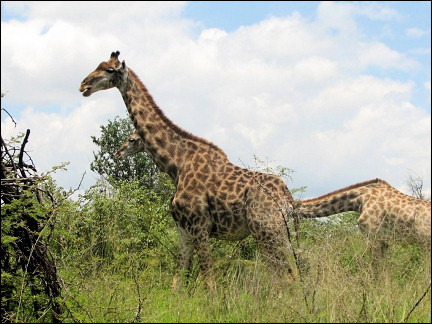
|
It apparently has rained at the camping site, because everything is drenched. On the way we didn't see any rain. We play cards by candlelight (another power outage) and have a tasty snack.
Hannah Game Lodge
White and black rhinoes? They're all brownish
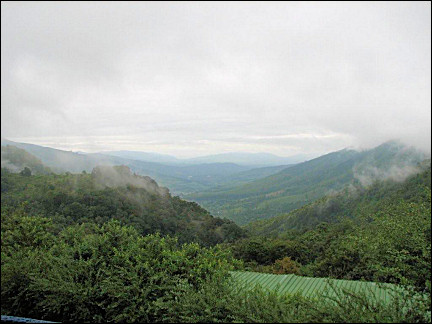
|
At 7:30 AM we drive to the exit of Marakele, very slowly, because on the way there is so much to see. Once we leave the park, we drive to Tzaneen, the largest town in the Letaba valley. Here vegetables and fruit, tobacco, coffee and tea are grown.
The Magoebas Canyon is the highlight; it meanders through the Wokbergen, mountains covered with native forest. Our hotel has a view of this gorgeous canyon and is aptly called Magoebaskloof Hotel.
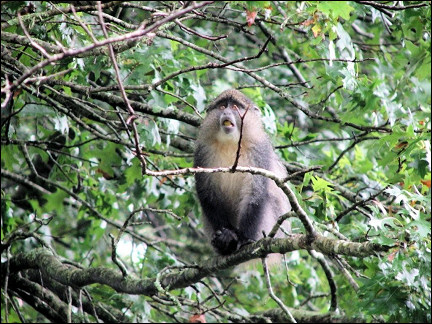
|
It's cold and foggy, but in the hotel bar a fire burns in the fireplace. We order a tasty drink. Outside there are blue monkeys everywhere; they are extremely bold and get very close. If they can, they'll even enter your room. That means one has to keep an eye on one's belongings.
A little after noon next day we arrive at the Hannah Game Lodge in Orighstad, where we will stay for two days. It is beautiful here, but not very warm. The lodge is located in a 8000 ha Private Nature Reserve and surrounded by unspoiled African nature. There are buffaloes, rhinoes, leopards and over 250 different kinds of birds.
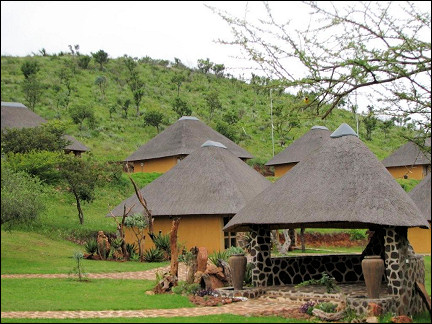
|
The Hannah Game Lodge consists of a main building and a large number of round cottages, in one of which we stay. We have a great view of the park.
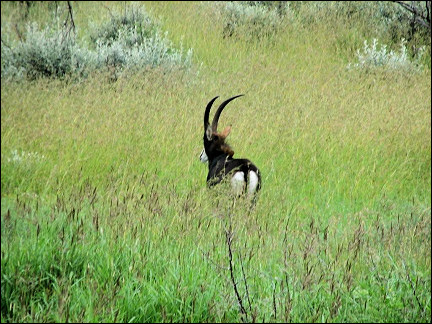
|
It's not allowed to drive in the park by yourself here, so toward the evening we enter the park with a guide. We see several kinds of antelope, mainly impalas, kudus and tsessebes, but also the sable antelope and - from a distance - white rhinoes, blue wildebeest and waterbucks.
Of course, there are also many birds, like marabou storks, long tailed whydahs and tawny eagles.
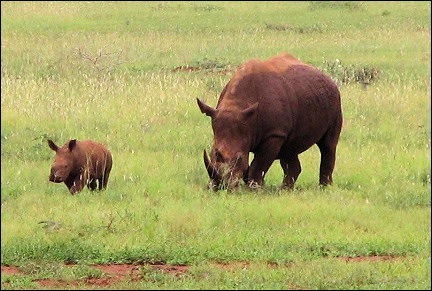
|
I ask our guide if there are white or black rhinoes here, but he doesn't think so: they're all brownish. The white rhinoes we saw, indeed looked brownish, but that was because of the red sand.
Mpumalanga Panorama route
Along bizarrely shaped rocks and 800 meters deep river valleys
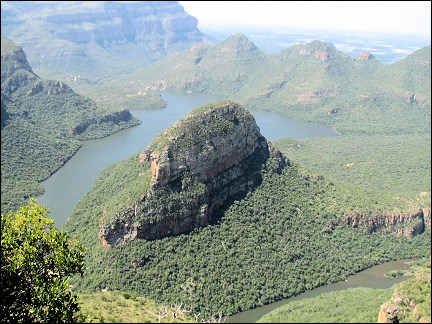
|
This is going to be a long day, we are going to take the Mpumalanga Panorama route, which is known as one of the highlights of north-east South Africa.
Our first stop is in Pelgrims Rest, a gold diggers village from the gold-fever era in Transvaal, late 19th century. The village has been declared a national landmark and is a living museum where time seems to have stopped. We drink a cup of capuccino with real gold in it and take a look at the old stores and pubs.
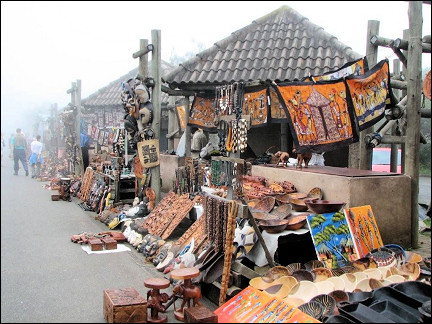
|
From a distance we see that meanwhile our car is being washed. And, no surprise, we are supposed to pay for it. Well, it's a way to earn some money. The guy asks 8 euro, we give 5; after all, we didn't ask him to do it.
When we continue our drive, we pass God's Window. When the weather is clear, one can look out over the 800 meters deep Blyde River Canyon, all the way to Kruger Park. But today it's foggy and we don't see anything at all.
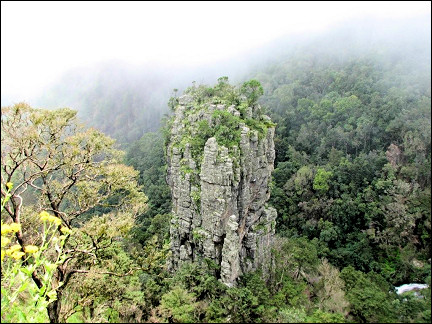
|
We drive to Pinnacle near Graskop, which also used to be a gold diggers village, but now it's a large center of the timber industry. On the way, there are souvenir markets everywhere, which specialize in wood carvings.
The Pinnacle is a gigantic stone pillar, which seems to rise from the earth. It's also a little foggy here.
The next sight along the Mpumalanga Panorama route is Bourke's Luck Potholes, named after the gold digger Tom Bourke, who claimed this location. Gold was found later near the potholes, exactly as he predicted.
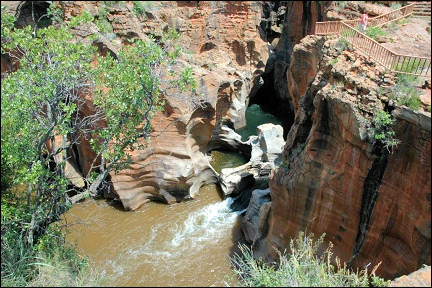
|
Bourke's Luck Potholes lies at the spot where the Blyde and Treur rivers merge. The "potholes", up to 6 meters deep cylinder-shaped holes were carved out in the rocks over a period of thousands of years by water, sand and stones.
Bourke's Luck Potholes sit at the entrance of the Blyde River Canyon, with its 33 km the third largest canyon in the world. It's breathtakingly beautiful and an impressive tangle of cliffs, islands and rock plateaus. Meanwhile it's getting hot, the sun shines brightly and there isn't a cloud in sight.
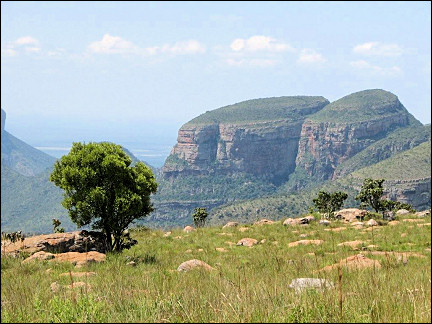
|
After lunch we drive to the Three Rondavels at the other end of Blyde River Canyon. These three giant round rocks are also called "the three sisters". They look like the round huts (rondavels) of indiginous people.
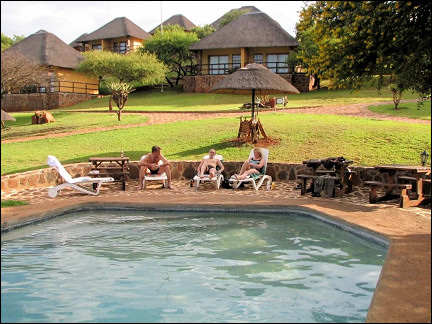
|
There is more to be seen on the Panorama route, but it's too much for one day. It's getting late and we return to the lodge, to swim and relax for a while.
Kruger National Park
With its 500 kinds of birds, it's South Africa's bird paradise
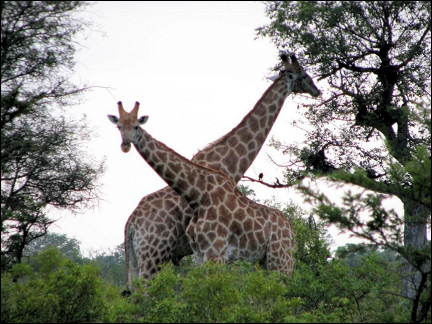
|
At 8 AM we leave for Kruger Park, one of the highlights of this trip. We will stay there for five days. There are rhinoes on the side of the road. On the way we visit Swadini Reptile Park. It's a little disappointing. There are a few crocodiles, some small iguanas and tortoises.
But in the garden there are many birds, among which the paradise flycatcher, the lilac breasted roller and many weavers, who are busy in and around their nests.
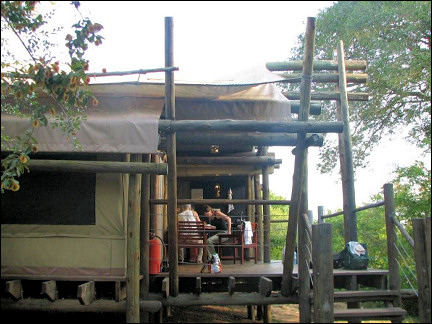
|
We stop for a quick lunch, but this is Africa and there is another power outage, so we have to wait for our pizza for over an hour.
We arrive at the Orpen Gate on the west side of Kruger Park by 1:30 PM. Tonight we will stay in Tamboti Tented Camp, in a tent with kitchen, shower and toilet. It is a wonderful location, surrounded by large Marula trees, at a distance of 2 km from the gate, on the mostly dry Timbavati river.
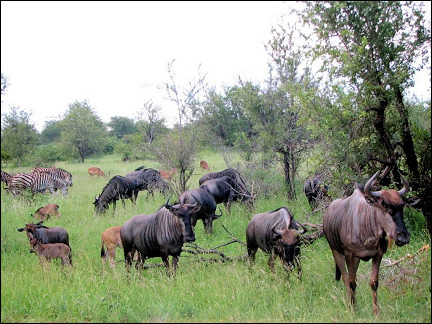
|
After unloading our stuff, we enter Kruger Park at 4 PM. It is the most famous and most important national park of South Africa, 380 km long and 60 km wide. That is over 20,000 square kilometers of unspoiled African nature.
The park was founded in 1898 by Paul Kruger. It has a huge game population. The Big Five are well represented, but there is also other game, like giraffes, cheetahs, hyenas, wild dogs, zebras, wildebeests, warthogs, waterbucks, kudus and impalas. At the same time, with its 500 different kinds of birds, Kruger park is South Africa's main bird paradise.
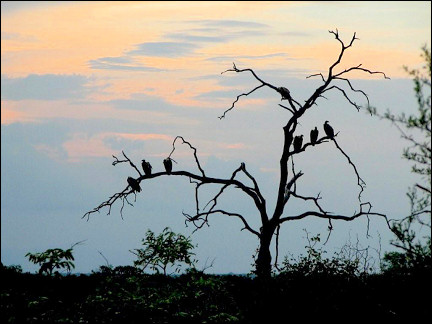
|
It's very hot and initially we don't see a lot of animals. When the sun sets and it gets a little cooler, the animals appear. We see white rhinoes, a buffalo herd, many zebras, giraffes, wildebeests, springbucks and impalas, baboons and several birds, among which a group of vultures in a tree.
When we get back at the camp, there is another power outage, so we have to cook our food on the barbecue again. For a long time, we sit outside and enjoy the sounds and the beautiful sky with many stars. It's still rather hot.
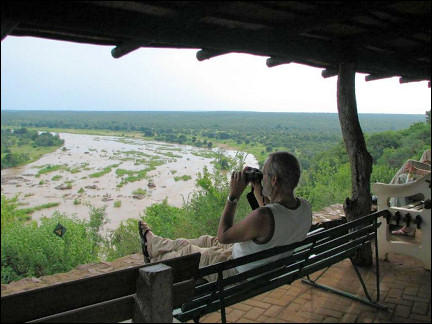
|
Next day we leave for Elephant's Rest Camp, trying to spot game on the way. This camp is located at a higher altitude on the east side of the park. On the way we have coffee at one of the many picnic sites in the Kruger Park.
We arrive by 4 PM. We stay in a bungalow with a gorgeous view of the park and Elephant's River. We buy a drink at the restaurant and sit down on a bench at the lookout. Hippoes walk in and out of the water everywhere. As far as the eye can see, there is forest; in some places stately baobabs rise high above the other trees.
Skukusa Rest Camp
A night safari in the safari jeep
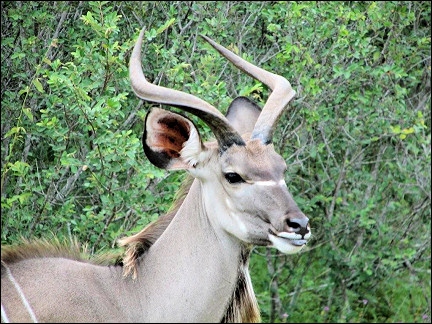
|
We travel to Skukuza on the south bank of the Sabie river. From Elephant's Rest Camp it's a distance of approximately 135 km, all the waky through the Kruger Park. On the way we see hippoes, elephants, kudus and birds, among which the woodland kingfisher, and the carmine bee eater.
All of a sudden Marga spots a leopard, nearby on a low-hanging branch. We back up the car and it's gone. We hardly saw it. Let's hope we get another chance.
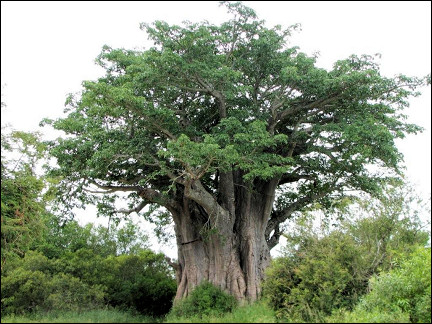
|
We stop at a huge baobab. According to Bushmen legend, the tree was thrown to earth as a punishment by the gods and landed upside down, so it looks as if its roots are in the air and its crown in the ground.
When we arrive at Skukuza Rest Camp it's already 4 PM. Skukuza is Kruger Park's main camp. It has a gas station, a post office, laundry, swimming pool, fast food restaurants and a store. We will spend two nights here, in a nice bungalow.
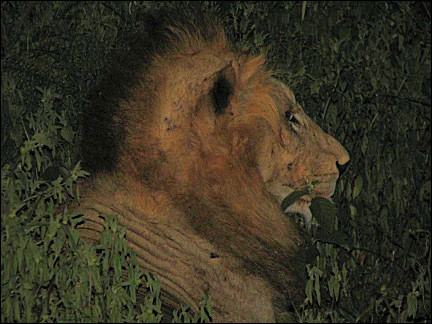
|
Tonight we have dinner in a grill restaurant in an old train station, which is completely authentic, including a train. On the platforms sit tables and the bar is in the train.
We get up at 2:45 AM for a night safari with a guide. We leave in a safari SUV, which has big spotlights. Inside are some extra lights. We immediately see a lion lying on the side of the road. When we stop, it jumps into the shrubs and stays there, we get a good look at it.
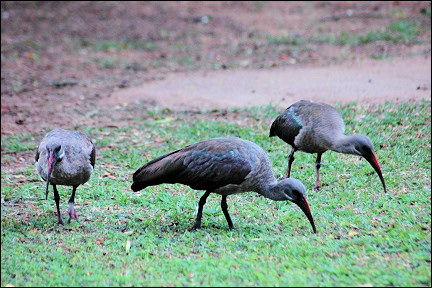
|
All of a sudden what I hoped for happens. Immediately in front of the car is an African wild dog or hyena dog, at the center of the spotlight. It has a beautiful color, black with brown dots. It bolts, the guide turns the car and follows it. It stays on the road for a short while, but then disappears into the bush.
These wild dogs are rare and you're lucky to get to see them at all. It's too dark for a picture, but the image will stay with me forever.
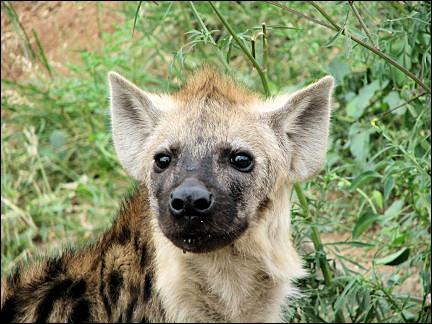
|
In the garden around our cottage live some hadada ibises. According to our neighbor, there are always hyenas near a ditch toward the Kruger Gate. We haven't seen any so far, so we go look for them.
And indeed, we find a spotted hyena with three pups, one of which is very small and completely black, the other two are bigger, already have their spots and are very cheeky. One of them even lies down underneath our car.
Hazyview
Impalas with birds on their heads
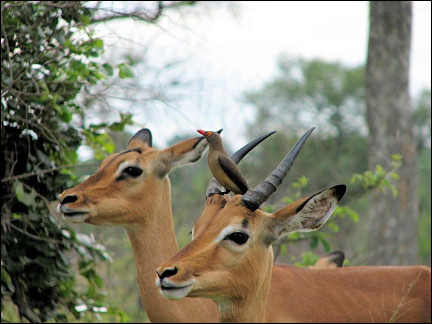
|
We leave Kruger Park for a visit to the farmers village Hazyview. On the way we see monkeys who sit down in the middle of the road, elephants and birds like the small bee eater and red-billed oxpeckers which sit on impalas.
The Gecko Lodge will be our home for the next two nights. The lodge lies beautifully hidden in a tropical garden in the Sabie River Valley, less then 12 km from Kruger Park.
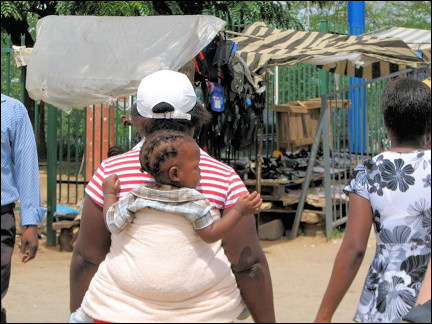
|
After lunch we visit Hazyview which is 3 km farther. It's very hot there, there is trash everywhere and it's even filthy. The people who live there don't seem to be thrilled with our visit, we are the only whites here.
It turns out there is a new center at a short distance. It's very different. New shops and restaurants. And it's clean. We have a drink and buy some souvenirs.
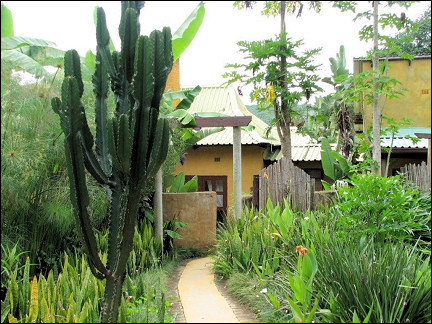
|
On our return to the lodge it starts to rain hard. We are sitting in the outdoor bar and have to move to the center to avoid getting wet.
Big Five in Kruger Park
High in a bare tree lies a leopard
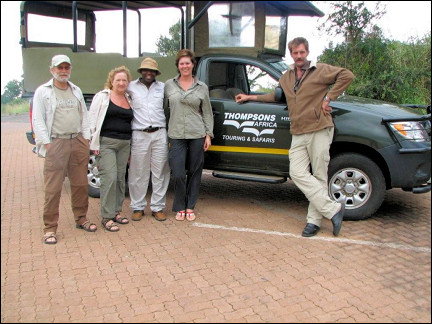
|
We return to Kruger Park for an all-day safari. Smartie, our guide, picks us up at 5 AM. He promises to show us all of the Big Five today. He's in a good mood and sings most of the time.
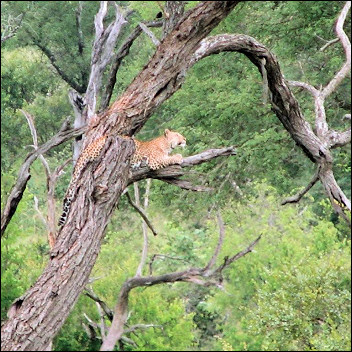
|
We say that we hope to see a leopard in any case. Half an hour into our safari, the guide suddenly says: "There is your leopard!" And indeed, there it is, lying high up in a bare tree. We have enough time to watch it before it jumps from the tree.
A little farther another bonus. A lion and lioness lie near the road. They look like a couple in love.
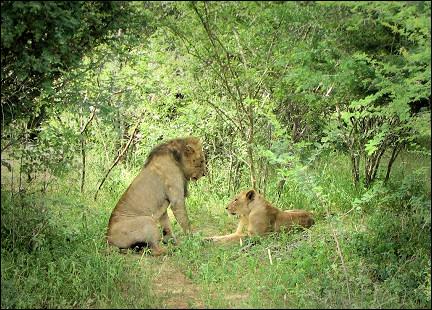
|
We also see enough rhinoes and elephants in the course of the day. What remains to be seen is the buffalo. We pass crocodiles and hippoes; two saddle-billed storks and a goliath heron stand in the water.
There is a couple of monkeys on the road and we see two crested francolins fighting. Giraffes cross the road. In a tree by the road sits a martial eagle.
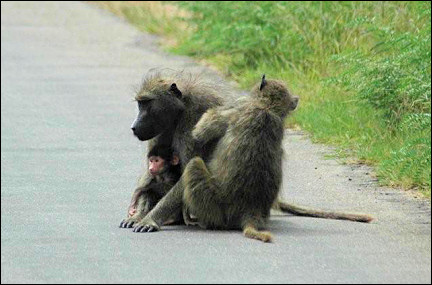
|
A little farther there are at least five cars. Bingo, another leopard! It is so well hidden between the branches of a tree, that we actually only see its tail really well.
Smartie stops the car again and peers at a tree. Initially we don't see anything, but then he points and we see a giant eagle owl.
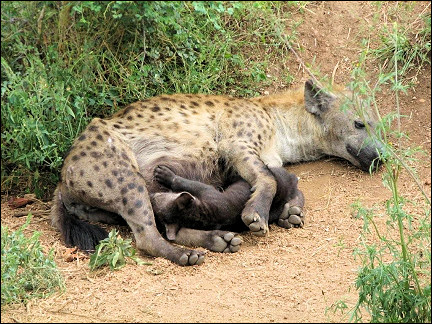
|
We drive for a long time through the grasslands to find buffaloes and cheetahs. But the grass is to high to spot cheetahs and the buffaloes don't show themselves. The guide doesn't like it at all. But it's getting late and we have to get back. On the way back, we see the hyenas again.
We're back at the Gecko Lodge at 5:30 PM. After dinner the men play some chess, coffee and cognac at hand, what more could a person want?
Unfortunately our vacation is over. From Hazyview it's approximately 450 km to Johannesburg Airport. At 8 PM the plane leaves and we see South Africa gliding away below us.